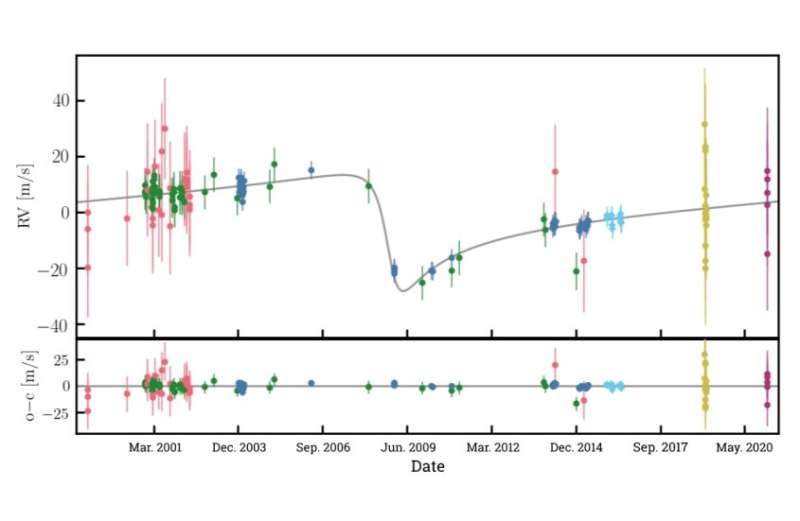The observational data for HD 83443, color coded as follows: Light blue - AAT, Green - HIRES/Keck, Blue - HARPS pre-correction, Red - HARPS post correction , Orange - Minerva-Australis ThAr and Purple - Minerva-Australis iodine. The panel shows the data for the long period planet HD 83443 c. Credit: Errico et al., 2022.
Astronomers report the discovery of another exoplanet around a nearby star known as HD 83443. The newfound extrasolar world is a Jupiter-mass planet orbiting its host on a highly eccentric 22-year orbit. The finding was detailed in a paper published April 12 on the arXiv pre-print server.
Located some 133 light years away, HD 83443 is a solar mass K0 star, with more than twice the metallicity of the sun. The age of this star is estimated to be 2.64 billion years and its effective temperature is around 5,429 K. HD 83443 is known to host a "hot Jupiter" exoplanet (designated HD 83443 b), with a mass of some 0.41 Jupiter masses, which orbits it approximately every three days.
Now, a team of astronomers led by Adriana Errico of the University of Southern Queensland in Australia, reports the detection of another giant planet orbiting HD 83443, which was suggested by previous studies. The finding is a result of analyzing radial velocity data from four instruments, namely: the University College London Echelle Spectrograph (UCLES) at the 3.9 m Anglo-Australian Telescope (AAT), the High Resolution Echelle Spectrometer (HIRES) at the Keck Telescope, the High Accuracy Radial velocity Planet Searcher (HARPS) at the ESO La Silla 3.6m telescope, and also the MINERVA-Australis telescope array at the Mount Kent Observatory.
"HD 83443 has been observed by four precise radial velocity instruments spanning a baseline of over 22 years. Here we give details about the observations from each instrument," the researchers wrote in the paper.
The newly found alien world received designation HD 83443 c. The results suggest that this planet has a dynamical mass of about 1.5 Jupiter masses, and orbits its host every 22.6 years, at a distance of approximately 8 AU from it.
The astronomers underlined that HD 83443 c orbits its parent star on an unusually highly eccentric orbit, measured to be 0.76. According to the authors of the study, such high eccentricity suggests that a scattering event may have sent HD 83443 b to its close orbit while leaving HD 83443 c on a wide and eccentric path. They even suppose that a third, less massive (with a mass lower than 0.4 Jupiter masses) planet may have participated in the scattering and was ejected.
The researchers noted that HD 83443 is a fascinating rare example of a well-characterized system containing both a hot Jupiter and a highly eccentric giant planet. Moreover, HD 83443 c turns out to be so far the most distant and highest-eccentricity companion to a hot Jupiter.
Summing up the results, the astronomers emphasize the necessity of further studies of this system in order to shed more light on the properties of the newfound planet. They suggest that HD 83443 c may be even a target if future direct imaging space missions.
"Although the host star is a bit far (∼ 41 pc) and dim (V mag ∼ 8), the planet could potentially be imaged by future direct imaging missions when it approaches periapsis, which will happen in about 10 years, thanks to its high planet-to-star flux ratio," the authors of the paper concluded.
More information: Adriana Errico et al, HD 83443 c: A highly eccentric giant planet on a 22-year orbit. arXiv:2204.05711v1 [astro-ph.EP], arxiv.org/abs/2204.05711
© 2022 Science X Network
























